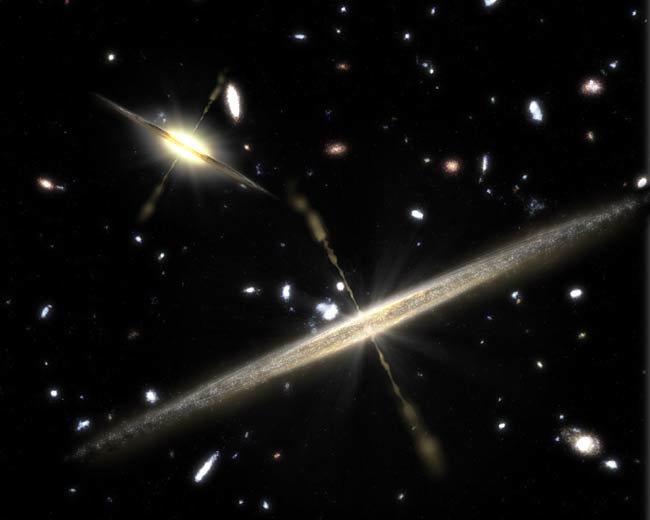Even Thin Galaxies Pack Hefty Black Holes

AUSTIN, Texas — A half-dozen hefty black holeshide out where they are least expected, in relatively skinny galaxies. The discoveryimplies galaxies don't need bulging bellies to harbor monstrous black holes.
Until now,astronomers had thought central concentrations of stars called galactic bulgeswere required for black holes to grow. Our own Milky Way, like most spiralgalaxies, has such a bulge. In many large galaxies, the bulge feeds bingeeating by theblack hole, creating a chaotic scene of high-speed consumption and copiousradiation.
Somesmaller and thinner galaxies — those without bulges — lack evidence forsupermassive black holes.
Newobservations from the Spitzer Space Telescope, however, show galactic obesityisn't the only path to black hole generation.
"Thisfinding challenges the current paradigm," said Shobita Satyapal of the George Mason University in Fairfax, Va. "The fact that galaxies without bulges have blackholes means that the bulges cannot be the determining factor." Satyapalpresented the research here at a meeting of the American Astronomical Society.
Instead,they think dark matter, an invisible substance thought to account for about 85percent of all matter in the universe, might play a role in the earlydevelopment of supermassive black holes.
Bulge orno bulge
Get the Space.com Newsletter
Breaking space news, the latest updates on rocket launches, skywatching events and more!
Pastresearch has shown the more massive the bulge, the more massive the associatedblack hole. That led astronomers to think a galaxy'sbulge and its supermassive black hole were intimately related.
Forinstance, our Milky Way is a massive disk of stars as seen from above. But ifviewed edge-on it would appear like the shape of an airplane viewed head-onwith its wings extended. The wings represent the galaxy's disk, and the bulbousfuselage would be the bulge.
The mostlydormant black hole at the center of our galaxy weighs several million times themass of the sun. In more active galaxies, black holes can surpass a billionsolar masses. (The record-setter,at 18 billion solar masses, was announced this week.)
"Scientistsreasoned that somehow the formation and growth of galaxy bulges and theircentral black holes are intimately connected," Satyapal said.
A fewrecent studies have caused astronomers to question the conventional thinking.In 2003, scientists discovered a relatively "lightweight"supermassive black hole in a bulge-less galaxy. And even more recently,Satyapal and her team spotted another supermassive black hole lurking in asimilarly svelte galaxy.
Now,Satyapal and her colleagues have turned up six more monstrous black holes inthin galaxies with minimal bulges.
Veiledby dust
Satyapalsuggests these black holes were only recently detected because they have beenshrouded by theirdusty abodes. Galaxies with such minimal midsections tend to be extremelydusty. Infrared light can penetrate the dust, meaning Spitzer could unmask theblack holes with its infrared capabilities.
"Afeeding black hole spits out high-energy light that ionizes much of the gas inthe core of the galaxy," Satyapal said.
Perhaps,Satyapal speculates, the missing piece of the black-hole puzzle is dark matter.Early on in the galaxy's life, this invisible matter might somehow set the massof the black hole. Other theorists have figured in recent years that darkmatter was integral to galaxy formation.
"Maybethe bulge was just serving as a proxy for the dark matter mass," Satyapalsaid. So the amount of dark matter is "the real determining factor behindthe existence and mass of a black hole in a galaxy's center."
The studywill be published in the April 10 issue of the Astrophysical Journal.
- Video: Black Holes: Warping Space and Time
- Video: Death Star Galaxy
- Top 10 Strangest Things in Space
Join our Space Forums to keep talking space on the latest missions, night sky and more! And if you have a news tip, correction or comment, let us know at: community@space.com.










